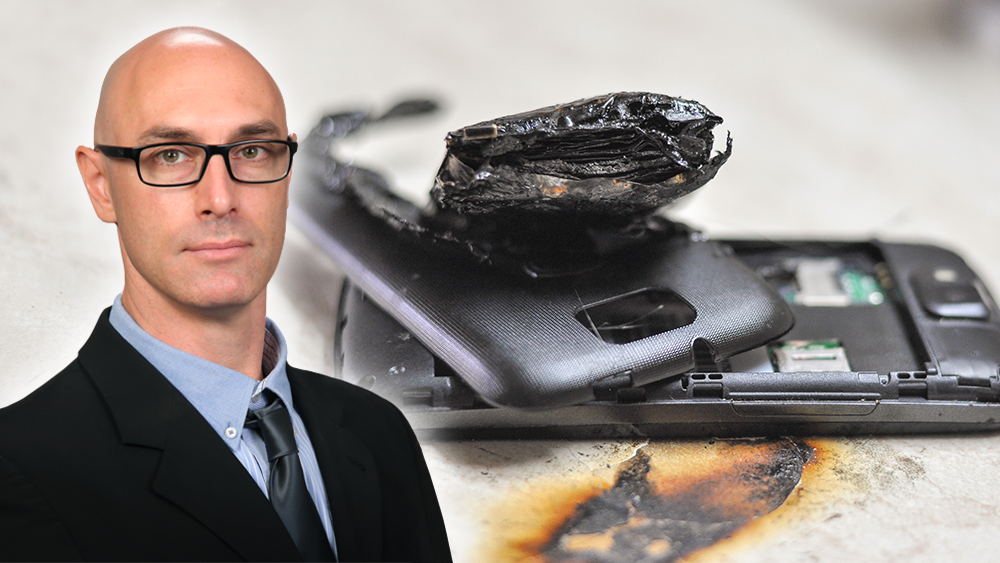By Steve Kuhlmann

Lithium-ion batteries have enabled the use of numerous technologies from smartphones and tablets to electric vehicles, but their convenience and versatility come at a cost — the potential for flammability.
Dr. Olivier Mathieu, research associate professor in the J. Mike Walker ’66 Department of Engineering at Texas A&M University, is working with his team to alleviate these concerns and reduce the risk of fire with the support of a three-year National Science Foundation grant.
Although these battery fires are relatively rare, Mathieu referenced two high-profile consumer examples to demonstrate the problem’s impact: Samsung’s 2016 recall of nearly 2 million smartphones following several fire events related to the device’s battery and General Motor’s 2020 recall of more than 50,000 Bolt electric cars over battery fire concerns during charging.
If successful, Mathieu said he hopes consumers will not even realize the research’s implementation into their daily lives.
“Ideally, the average person will not see how this research will impact their lives and the batteries of their phones, connected devices or electric vehicles will never catch fire,” said Mathieu. “They will just see the positive aspect of new technology around them and not experience this particularly dangerous — but fortunately rare — aspect of it.”
Mathieu noted that the increased prominence of electric vehicles on the roadways is an added motivation for accelerating the search for a solution. Particularly in the case of a vehicle collision, Mathieu said the dangers posed to electric vehicle batteries could be quite different from a traditionally fueled car.
“The battery of electric vehicles is large and can be damaged during an impact,” Mathieu said. “This could lead to a short-circuit, a scenario where the battery will heat up and eventually burn due to the flammable electrolyte.”
Mathieu said first responders had reported difficulty in putting out the fires caused by these lithium-ion batteries. In some cases, he said the batteries have even been reported to reignite up to a day later.
“Preventing the fire from happening in the first place is, therefore, the best solution and I hope our research will allow identifying the right fire suppressants that will suppress the flammability issue of the electrolyte,” said Mathieu.
To address this problem, Mathieu and his team are investigating how the electrolytes of lithium-ion batteries burn and searching for the best fire suppressants that could be added to reduce flammability.
Mathieu said his team’s approach to the problem is largely based on fundamental science, allowing them to use predictive models to identify the ideal fire suppressants for the task.
“To find fire suppressants that are efficient at the chemical level, it is important to understand first the detailed combustion chemistry of the electrolyte,” said Mathieu. “Therefore, our approach consists of studying experimentally the combustion chemistry of the various constituents of the electrolyte, developing and validating detailed kinetics models, and finally to using this knowledge to identify the best fire suppressants and their ideal concentration.”
This approach contrasts with similar research into the same topic, which Mathieu said often involves long trial and error procedures that typically place the batteries in conditions unlike those it would experience in the real world when overheating.
Moving ahead, the most significant challenge Mathieu and his team anticipate is applying the necessary concentration of the identified fire suppressant without compromising the performance of the battery.
“Degrading the battery performance or longevity must, of course, be avoided,” Mathieu said. “This would eventually require working hand-in-hand with a lithium-ion battery manufacturer. Research in this area is just starting and I hope to be able to have this kind of partnership in the future.”
As a research associate professor working primarily with the Turbomachinery Laboratory, Mathieu said he and those in his position serve a valuable role in the lab alongside tenure-track faculty in addition to bringing in financial support through research contracts and grants, such as this project.
“Research professors can be a steady presence in the lab, always available to answer the infinite number of questions students have and make things run a bit faster and easier for the group leader in the end,” Mathieu said. “There is a large one-on-one teaching role in the lab and because they are also devoted to research, I think research professors can benefit the department by providing even more exposure at the research level.”
The Texas A&M Engineering Experiment Station (TEES) Turbomachinery Laboratory makes a vital impact on turbomachinery and related industries through research, education and professional workforce development.
